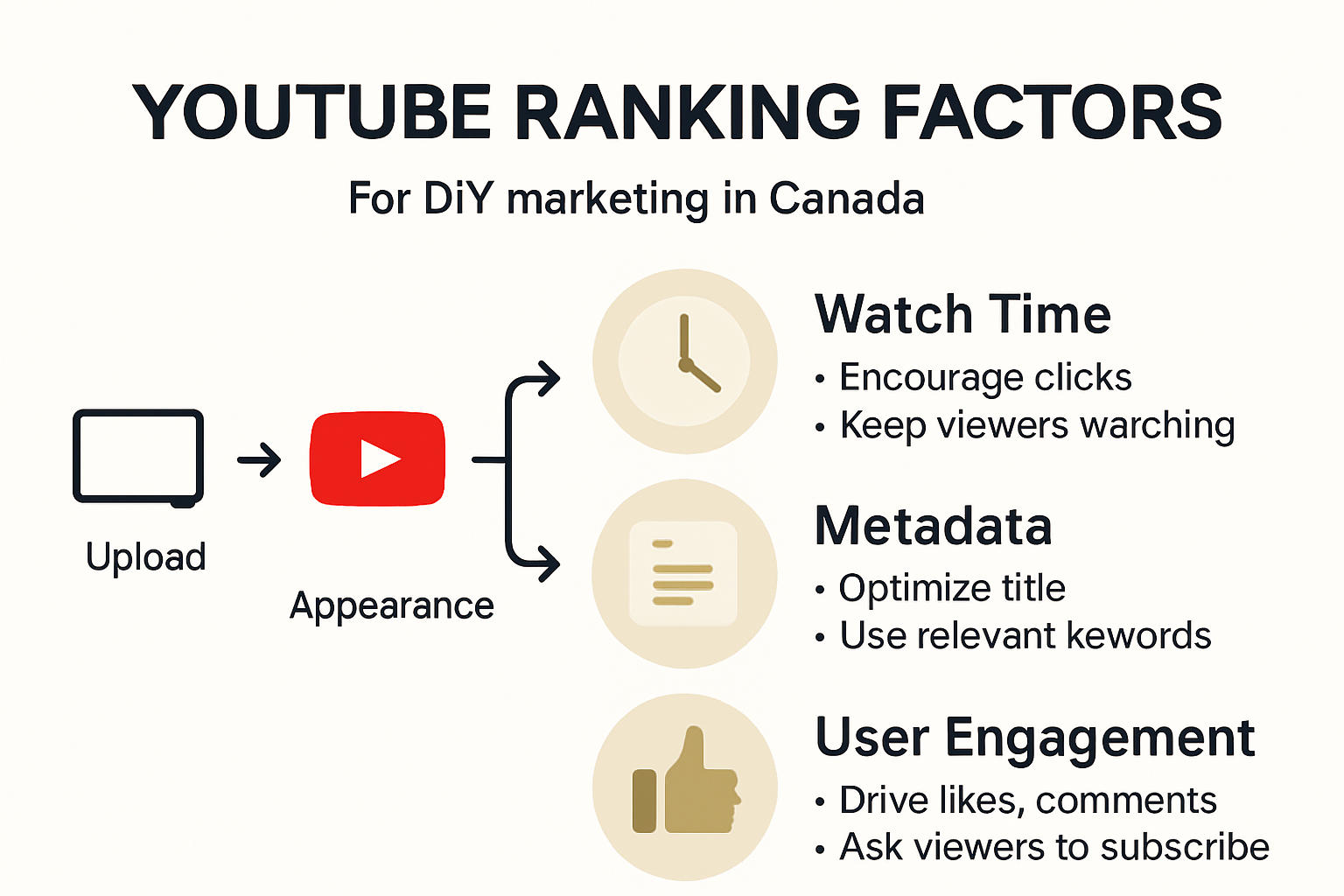Top YouTube SEO Tips for Canadian DIY Marketers in 2025

Canadian DIY marketers are making a splash on YouTube, but only a fraction know how to truly get found in the endless sea of videos. Most channels fade into the background while a small group soars ahead. Videos that rack up strong watch time can rank up to 300 percent higher in search results compared to those with poor retention. The wild part? It’s not just about slick editing or high budgets. The real difference comes from understanding YouTube’s algorithm and applying just a few smart SEO moves.
Table of Contents
Quick Summary
| Takeaway | Explanation |
|---|---|
| Understand YouTube’s Algorithm | Comprehend the factors like watch time and user engagement that influence video rankings on YouTube’s search. |
| Optimize Metadata Strategically | Craft compelling titles, descriptions, and tags using relevant keywords that are natural and informative. |
| Create Engaging Thumbnails | Design high-quality thumbnails that evoke emotions and clearly represent video content to attract clicks. |
| Utilize Playlists Effectively | Organize videos into themed playlists to improve viewer navigation and increase overall watch time. |
| Leverage Analytics for Improvement | Track key metrics like watch time and audience retention to refine your content strategy and boost performance. |
Understanding How YouTube Search Works

YouTube search is a complex ecosystem driven by sophisticated algorithms designed to match user queries with the most relevant video content. For DIY marketers aiming to improve their YouTube SEO tips strategy, comprehending these search mechanics becomes crucial for visibility and audience engagement.
The Algorithmic Foundation of YouTube Search
At its core, YouTube’s search algorithm evaluates multiple signals to determine video rankings. Research from ACM publications reveals that the platform considers far more than simple keyword matching. The algorithm prioritizes user engagement metrics, content relevance, and viewer interaction patterns.
Key ranking factors include watch time, which measures how long viewers stay engaged with a video. Videos that retain audience attention are perceived as higher quality and more likely to be recommended. This means creating compelling content that keeps viewers watching becomes a critical YouTube SEO strategy.
User interaction signals play a significant role in search rankings. Comments, likes, shares, and subscription rates after watching a video provide strong indicators of content quality. The more positive interactions a video generates, the more likely YouTube will elevate its search visibility.
Metadata and Contextual Relevance
A comprehensive research paper highlights the importance of metadata in YouTube search optimization. Title, description, and tags are not just supplementary information but critical components that help the algorithm understand a video’s content and context.
Effective metadata requires strategic keyword placement that feels natural and descriptive. This means avoiding keyword stuffing while ensuring your video’s textual elements accurately represent its content. The goal is to create metadata that both appeals to the algorithm and provides genuine value to potential viewers.
Content freshness is another crucial factor. YouTube tends to prioritize recent videos that align with current search trends. This means regularly updating your content and staying attuned to your audience’s evolving interests can significantly improve your search rankings.
Understanding User Intent
Successful YouTube SEO goes beyond technical optimization. It requires a deep understanding of user intent. Canadian DIY marketers must think like their target audience, anticipating the questions and solutions viewers seek.
Consider the search queries your potential viewers might use. Are they looking for tutorials, product reviews, or entertainment? Aligning your video content with these specific intents increases the likelihood of appearing in relevant search results.
By comprehending how YouTube’s search algorithm evaluates and ranks content, DIY marketers can develop more strategic approaches to video creation and optimization. Remember, success on the platform is not just about creating content but creating content that genuinely serves and engages your audience.
Optimizing Titles, Descriptions, and Tags
Optimizing your YouTube video metadata is a critical strategy for improving search visibility and attracting your target audience. Canadian DIY marketers must master the art of crafting compelling titles, descriptions, and tags that not only appeal to the YouTube algorithm but also engage potential viewers.
Crafting Compelling Video Titles
The Digital Marketing Institute provides crucial insights into creating effective video titles. The key is to integrate relevant keywords strategically, placing them at the beginning of the title to maximize search visibility. Titles should be concise and clear, avoiding truncation in search results.
Consider your title as a first impression. It should be both informative and enticing, clearly communicating the video’s value proposition. For DIY marketers, this means using specific, action-oriented language that speaks directly to viewer needs. Instead of a generic title like “Home Repair Tips,” opt for something more specific like “5 Quick DIY Home Repairs Any Canadian Homeowner Can Master.”
Avoid clickbait tactics. While an attention-grabbing title is important, it must accurately represent the video’s content. Misleading titles can lead to negative user interactions, potentially harming your channel’s search rankings.
Maximizing Description Potential
The University of California, Davis recommends crafting descriptions between 200-350 words, with a strategic approach to keyword placement. The first few sentences are crucial, as they provide immediate context for both viewers and the YouTube algorithm.
Boston University emphasizes the importance of incorporating target keywords naturally within the first 25 words of your description. Aim to use keywords 2-4 times, ensuring they flow seamlessly within the text. The description should provide additional context, include relevant links, and offer value to potential viewers.
A well-crafted description serves multiple purposes. It helps viewers understand what to expect from the video, provides additional searchable text for the algorithm, and can include calls-to-action or links to related content. For DIY marketers, this might mean including timestamps, additional resources, or links to related tutorials.
Strategic Tag Implementation
Tags are often overlooked, but they play a crucial role in YouTube SEO. Think of tags as additional keywords that help the algorithm understand your video’s context and content. Start with broad tags that describe the overall topic, then narrow down to more specific, long-tail keywords.
Consider using a mix of different tag types. Include general category tags, specific topic tags, and even tags related to common search queries in your niche. For a DIY home repair video, tags might include “home repair,” “DIY home improvement,” “Canadian home maintenance,” and specific technique-related tags.
Avoid overloading your video with tags. Quality trumps quantity. Choose tags that are genuinely relevant and reflective of your content. YouTube’s algorithm is sophisticated enough to recognize and potentially penalize tag stuffing.
By carefully optimizing your titles, descriptions, and tags, you create a powerful strategy for improving your YouTube search visibility. Remember, the goal is to create metadata that serves both the algorithm and your potential viewers, providing clear, valuable information that encourages clicks and engagement.
To help you spot the differences and key uses of video metadata, here’s a summary table outlining best practices for titles, descriptions, and tags for Canadian DIY marketers:
| Metadata Element | Best Practices | Purpose |
|---|---|---|
| Title | - Place relevant keywords at the start |
- Make concise and specific
- Use action-oriented language
- Avoid clickbait | Improve search visibility and attract clicks | | Description | - 200-350 words long
- Include keywords in first 25 words
- Use keywords 2-4 times naturally
- Add extra context, links, calls-to-action | Help YouTube algorithm and viewers understand video content | | Tags | - Use broad and specific tags
- Include common search phrases
- Avoid irrelevant or excessive tags | Enhance discoverability by clarifying video context |
Leveraging Thumbnails and Playlists Smartly
Thumbnails and playlists are powerful yet often underutilized tools in YouTube SEO strategy. For Canadian DIY marketers, mastering these elements can significantly enhance channel visibility, viewer engagement, and overall search performance.
Creating Compelling Thumbnails
Thumbnails serve as the visual gateway to your content, acting as the first point of attraction for potential viewers. They function similarly to book covers or movie posters - a single image that must communicate value, intrigue, and quality within seconds.
Designing effective thumbnails requires a strategic approach. Use high-resolution images that are clear and visually striking, even when viewed in smaller formats. Include bold, readable text that complements the video’s title and provides additional context. The text should be large enough to be legible on mobile devices and use contrasting colors to stand out.
Consider incorporating emotional triggers in your thumbnails. Whether it’s surprise, curiosity, excitement, or problem-solving anticipation, the image should evoke a reaction that compels viewers to click. For DIY content, this might mean showing a dramatic before-and-after transformation or capturing a moment of surprising complexity or simplicity in a project.
Strategic Playlist Organization
Playlists are more than just a convenient way to group videos. They represent a powerful YouTube SEO strategy that can increase watch time, improve channel authority, and create a more engaging user experience. By organizing content into logical, thematic collections, you help viewers navigate your channel more effectively.
When creating playlists, focus on developing coherent storylines or learning journeys. For a DIY channel, this might mean creating playlists like “Beginner Home Repairs,” “Advanced Woodworking Techniques,” or “Budget-Friendly Home Improvements.” Each playlist should have a clear theme that guides viewers through a progressive learning experience.
Playlist titles and descriptions are crucial for search optimization. Use descriptive, keyword-rich titles that clearly communicate the playlist’s value. Include a comprehensive description that explains what viewers will learn or experience, incorporating relevant keywords naturally.
Engagement and Retention Strategies
Both thumbnails and playlists play critical roles in viewer retention and engagement. A well-designed thumbnail can increase click-through rates, while a strategically organized playlist encourages continuous viewing.
Implement a consistent visual style across your thumbnails to build brand recognition. This doesn’t mean using identical designs, but rather maintaining a recognizable color scheme, font style, or graphic element that viewers can instantly associate with your channel.
Use playlists to create natural content progression. Arrange videos in a way that naturally leads viewers from one topic to the next. For instance, a playlist about home renovation might start with basic assessment techniques, move through planning stages, and conclude with execution and finishing touches.
Track the performance of your thumbnails and playlists using YouTube Analytics. Pay attention to metrics like click-through rates, average view duration, and playlist completion rates. These insights will help you refine your approach and create more compelling visual content.
By treating thumbnails and playlists as integral components of your YouTube SEO strategy, Canadian DIY marketers can create a more engaging, discoverable, and professional channel. Remember, the goal is not just to attract viewers, but to keep them watching and coming back for more.
Below is a summary checklist table to help Canadian DIY marketers ensure they are maximizing the effectiveness of thumbnails and playlists:
| Element | Action Item | Status (Yes/No) |
|---|---|---|
| Thumbnail | High-resolution and clear images | |
| Thumbnail | Bold, readable, and contrasting text | |
| Thumbnail | Emotional triggers (e.g., curiosity, excitement, surprise) | |
| Thumbnail | Consistent visual style across thumbnails | |
| Playlist | Thematic, keyword-rich titles and descriptions | |
| Playlist | Logical content progression/order | |
| Playlist | Encourages longer viewing sessions |
Tracking YouTube SEO Success with Analytics
Analytics are the compass that guides YouTube SEO strategy, providing critical insights into content performance and audience behavior. For Canadian DIY marketers, understanding these metrics is essential to refining content and improving search visibility.
Understanding Key Performance Metrics
Yoast’s comprehensive guide highlights the importance of tracking specific performance indicators that reveal your channel’s true engagement and reach. Watch time emerges as a crucial metric, signaling to YouTube’s algorithm that your content delivers genuine value.
Key metrics to monitor include watch time, audience retention, click-through rates, and traffic sources. Watch time demonstrates how long viewers remain engaged with your content. A higher watch time suggests your videos effectively capture and maintain viewer interest, which directly influences search rankings.
Audience retention graphs provide granular insights into viewer behavior. These visualizations reveal precisely where viewers lose interest, enabling DIY marketers to identify and eliminate content weak points. By understanding these drop-off moments, you can create more compelling, targeted content that keeps viewers watching.
Advanced Traffic Source Analysis
FreeCodeCamp’s tutorial recommends integrating Google Analytics with YouTube for deeper performance insights. This approach allows you to track traffic sources beyond YouTube’s native analytics, understanding how viewers discover your content.
Analyze where your traffic originates: YouTube search, suggested videos, external websites, or social media platforms. This information helps you optimize your cross-platform marketing strategy and identify which channels are most effective for content distribution.
Demographic data provides another layer of strategic insight. Understanding your audience’s age, location, and viewing preferences allows you to tailor content more precisely. For Canadian DIY marketers, this might mean creating region-specific content or addressing unique home improvement challenges relevant to local audiences.
Transforming Insights into Strategy
Coursera’s YouTube Analytics course emphasizes that data interpretation is an art. It’s not just about collecting numbers, but understanding the story they tell about your content’s performance.
Establish baseline metrics for your channel, then set realistic, measurable goals for improvement. This might involve increasing average watch time by 10%, improving click-through rates, or expanding audience demographics. Regularly review these metrics and adjust your content strategy accordingly.
Consider creating a monthly analytics review process. Document key performance indicators, identify trends, and brainstorm content improvements. This systematic approach transforms analytics from a passive reporting tool into an active strategy development mechanism.
Remember that YouTube’s algorithm continuously evolves. What works today might change tomorrow. Consistent analytics tracking allows you to remain agile, adapting your YouTube SEO strategy to emerging trends and viewer preferences.
By treating analytics as a strategic roadmap rather than a mere reporting tool, Canadian DIY marketers can develop more targeted, engaging content that resonates with their audience and improves search visibility. The data tells a story - your job is to listen and respond strategically.

Frequently Asked Questions
What are the key factors influencing YouTube SEO in 2025?
The primary factors influencing YouTube SEO include watch time, user engagement metrics, and metadata relevance. Videos that retain viewer attention and encourage interactions like comments and shares rank higher in search results.
How important are titles and descriptions for YouTube video optimization?
Titles and descriptions are crucial for YouTube video optimization as they provide context to both viewers and the algorithm. Effective titles should include relevant keywords, while descriptions should be informative and structured to enhance search visibility.
How can Canadian DIY marketers improve their video thumbnails?
To improve video thumbnails, use high-resolution images, bold and readable text, and include emotional triggers that attract viewers. A consistent visual style across thumbnails also helps build brand recognition and encourages clicks.
What metrics should I track to measure my YouTube SEO success?
Key metrics to track include watch time, audience retention, click-through rates, and traffic sources. These indicators help understand viewer engagement and identify areas for content improvement.
Ready to Turn YouTube SEO Wins Into Real Business Growth?
You already know the importance of watch time, metadata, and audience retention for boosting your DIY channel on YouTube. Yet, many Canadian marketers struggle to connect those digital insights to real business growth. It is tough to stand out if your website and Google Business Profile are not optimised too. Imagine what happens when your YouTube discoverability blends seamlessly with top search rankings in your local market. Suddenly, those views can become calls, leads, and new customers.

If you want your business to rank in the top 3 on Google while getting the most out of your YouTube strategy, let our local experts at Freedom SEO help. We specialize in Local SEO services for Canadian businesses , Google Business Profile optimization, and results-driven web builds. Take the next step—reach out for your free consultation now and move your business up where local customers are searching for you.
Recommended
















